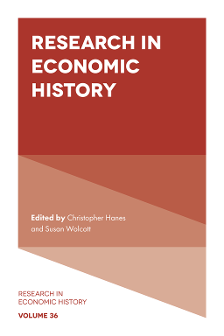Research in Economic History: Volume 36

Table of contents
(7 chapters)Abstract
Using an original product level database, this article analyzes the nature and dynamics of Swiss specializations during the “first globalization” (1850–1913). I study the comparative advantages, as well as the evolution of the trade structure, in order to understand economic performance differences between Switzerland and France. Despite differences in terms of market size, some common trends are identified. I also argue that Switzerland's skilled labor force, along with an intelligent choice of economic policy, allowed this country to adapt its specialization structure to global demand and enjoy rapid economic growth.
Abstract
This chapter sheds light on long-term trends in the level and structural dynamics of investments in Russian human capital formation from government, corporations, and households. It contributes to the literature discussing theoretical issues and empirical patterns of modernization, human development, as well as the transition from a centralized to a market economy. The empirical evidence is based on extensive utilization of the dataset introduced in Didenko, Földvári, and Van Leeuwen (2013). Our findings provide support for the view expressed in Gerschenkron (1962) that in late industrializers the government tended to substitute for the lack of capital and infrastructure by direct interventions. At least from the late nineteenth century the central government's and local authorities' budgets played the primary role. However, the role of nongovernment sources increased significantly since the mid-1950s, i.e., after the crucial breakthrough to an industrial society had been made. During the transition to a market economy in the 1990s and 2000s the level of government contributions decreased somewhat in education, and more significantly in research and development, but its share in overall financing expanded. In education corporate funds were largely replaced by those from households. In health care, Russia is characterized by an increasing share of out-of-pocket payments of households and slow development of organized forms of nonstate financing. These trends reinforce obstacles to Russia's future transition, as regards institutional change toward a more significant and sound role of the corporate sector in such branches as R&D, health care, and, to a lesser extent, education.
Abstract
In this chapter, network analysis has been used to map out disciplinary areas of research and authorship in economic history. A total of 5,330 peer-reviewed articles published in the leading economic history journals has been surveyed. Since 1980, the number of publications has risen and then rapidly accelerated over the last 2 decades. This rise has been fueled by research being conducted within European universities instead of US or UK ones.
Abstract
We construct a new consumer price index for Canada covering the period from 1870 to 1900. Unlike previous indexes, it includes prices of clothing and household furnishings. This is important because these previously neglected components accounted for roughly 20% of consumers' expenditures. Moreover, the price of cotton goods, the most important textile product used for clothing and household furnishings, fell by half between 1870 and 1900 (much faster than other components of the price level). This has ramifications for both the level and trend of Canadian GDP. Because the largest changes in estimation concern the 1870s, we show that the country grew substantially faster than generally believed. It outpaced the United States so much that it entered the twentieth century with an improved economic standing relative to its southern neighbor.
Abstract
This chapter explores the political economy of banking in Texas at the turn of the last century. The empirical work sheds light on why Texans voted to allow the chartering of banks by the state government. The evidence shows that county-level voting patterns for state-chartered banks were significantly related to business interests, consumer interests, agricultural activity, and the presence of existing national banks. The work also shows that the first counties to receive the new state banks were associated with higher agricultural activity, larger population size, and the presence of existing national banks. By examining the vote and the location of early entrants in state banking, this chapter contributes to the literature exploring the historical development of state-chartered banking and the dual-banking system in the US.
Abstract
We develop the concept of the slave-trade balance of payments and generate its table for the United States for 1790–1860. In the process, we construct new data for the slave trade, including both the physical movement and revenue figures, and we analyze these numbers. The balance of payments includes slave imports, carrying trade in slaves, purchases of slaves that fail to be imported, outfitting and provisioning slave ships, and slave-ship sales. The slave-trade balance is integrated into the standard balance of payments. Among the findings are the following: slave imports were dominated by natural growth except for one decade; US ships had the greater role than foreign ships in the import trade, but were of small—and eventually nil—consequence in the carrying trade; federal and state laws to prohibit the slave trade in all its aspects were generally effective; and the slave-trade balance of payments was a small component of the overall balance.

- DOI
- 10.1108/S0363-3268202036
- Publication date
- 2020-09-30
- Book series
- Research in Economic History
- Editors
- Series copyright holder
- Emerald Publishing Limited
- ISBN
- 978-1-83909-180-3
- eISBN
- 978-1-83909-179-7
- Book series ISSN
- 0363-3268